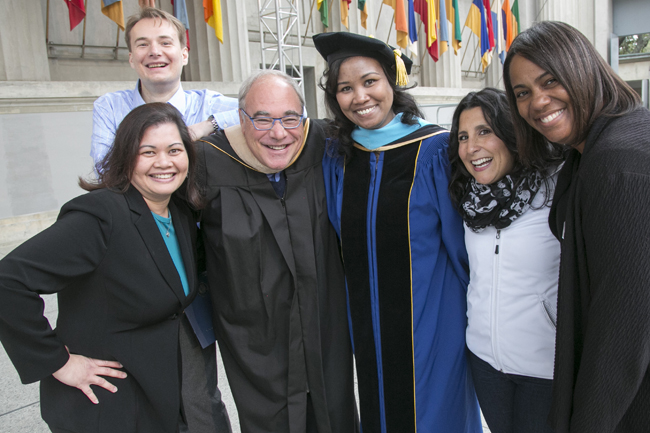
Erika Walker, assistant dean of the undergraduate program at Berkeley Haas is pictured center with her team. Photo by Jim Block
Sometimes, stature can be deceptive. And with about 700 undergraduate students, the University of California-Berkeley Haas School of Business is indeed small in stature when compared with The Wharton School (more than 2,500 undergrads), Notre Dame’s Mendoza (nearly 2,000 undergrads), and many others. But in terms of quality of education and students, this David of a business school can go toe-to-toe with any Goliath. Nestled in between the Eucalyptus covered Berkeley hills and historically avant-garde and counterculture hub, Telegraph Avenue, the school largely reflects its surroundings—diverse, progressive, and atypical.
Berkeley Haas’ undergraduate program is two years (one of the reasons for a relatively small population) and students either enter as continuing Berkeley students or transfer students. The school reserves about 260 slots for students already enrolled at UC-Berkeley and about 90 slots for students transferring from community colleges. And the competition for a spot is fierce. This past application cycle, the school saw nearly 700 continuing UC-Berkeley applications and almost 1,800 transfer applicants. This, of course, comes at little surprise considering the school’s placement in rankings. Poets&Quants ranks the school at 6th. The U.S. News & World Report rankings have Berkeley Haas tied with MIT’s undergraduate program at 2nd.
Once in the program, students can expect a global management-oriented curriculum with a strong liberal arts twist. They can also expect to be around other students who aren’t like themselves. For the entering class of 2016, more than 61% are minorities and another 46% are women. According to Erika Walker, assistant dean of undergraduate studies at Berkeley Haas, students desired by the school also have a diverse educational background. For example, many have already started businesses or held leadership roles of some sort.
Any other doubt of Berkeley Haas’ strength is met with robust employment stats. For the class of 2014, 85% had jobs secured three months after graduation. But don’t let the proximity to tech-rich Silicon Valley fool you. In 2014, the majority of graduates ended up accountancy (34%), consulting services (24%), or financial services (20%). Technology and science was the next most popular career path at 17%. Although, when the tech giants are hiring, they’re definitely looking closely at UC-Berkeley.
According to earlier Poets&Quants’ reporting on Payscale data, Berkeley Haas graduates make more on average at entry-level ($72,000 with five years or less of experience) and mid-career ($138,300 at 15 years of experience) than graduates of any other business school in the United States. Haas graduates also enjoy a better ROI than graduates of other schools—seeing more than a $1.1 million return after 20 years for in-state tuition and more than $1 million for out-of-state tuition.
Walker, who recently sat down for an interview with Poets&Quants, has been at Berkeley Haas for more than a decade. In 2014, she became the assistant dean for undergraduate studies. In this interview, Walker outlines everything from new and upcoming curriculum developments to how Haas is making changes to appease the millennial generation.
Poets&Quants: What’s going on that’s new and unique at Haas?
Erika Walker: Well, I think first I should probably explain just how our program is set up because we are a little different from how other programs are set up. There are some programs like us, but we’re a two-year program. So students actually apply to us in their second year, during their sophomore year. And we’re a general management program, so we don’t have majors within the major. We have one general program, which is global management. But other than that, students are getting a general management education, and there’s flexibility within the major. So, they’re able to take all the core classes and then they can pick-and-choose and kind of tailor to their interests the various electives that are available to them.
One way in which we are very similar to other programs is that students are required to take business courses, but they’re also required to take courses outside of business within liberal arts. And that’s a degree requirement. So that’s the way in which we’ve approached liberal arts and making sure that was part of an undergraduate business education.
But what’s changing in terms of what’s new is we’re starting to really be more intentional about how we integrate liberal arts into undergraduate business education [and] into the curriculum. Where we’ve called it integrated liberal arts before, I would say now it’s more kind of a comprehensive liberal arts integration where the curriculum that we’re developing is built around the framework of business concepts and how you might utilize this as a young manager. But, we’re drawing more explicitly on the other disciplines like psychology or like anthropology and looking at ethnography. So, whether or not we’re trying to understand our customers better or trying to understand ourselves as leaders and as someone who might have impact within society or within organizations, we’re really starting to be more explicit about that. And so, naturally, we’ve got new courses that are evolving out of it. So many of our courses are starting to take a different shape. And I think that’s really exciting.











Questions about this article? Email us or leave a comment below.